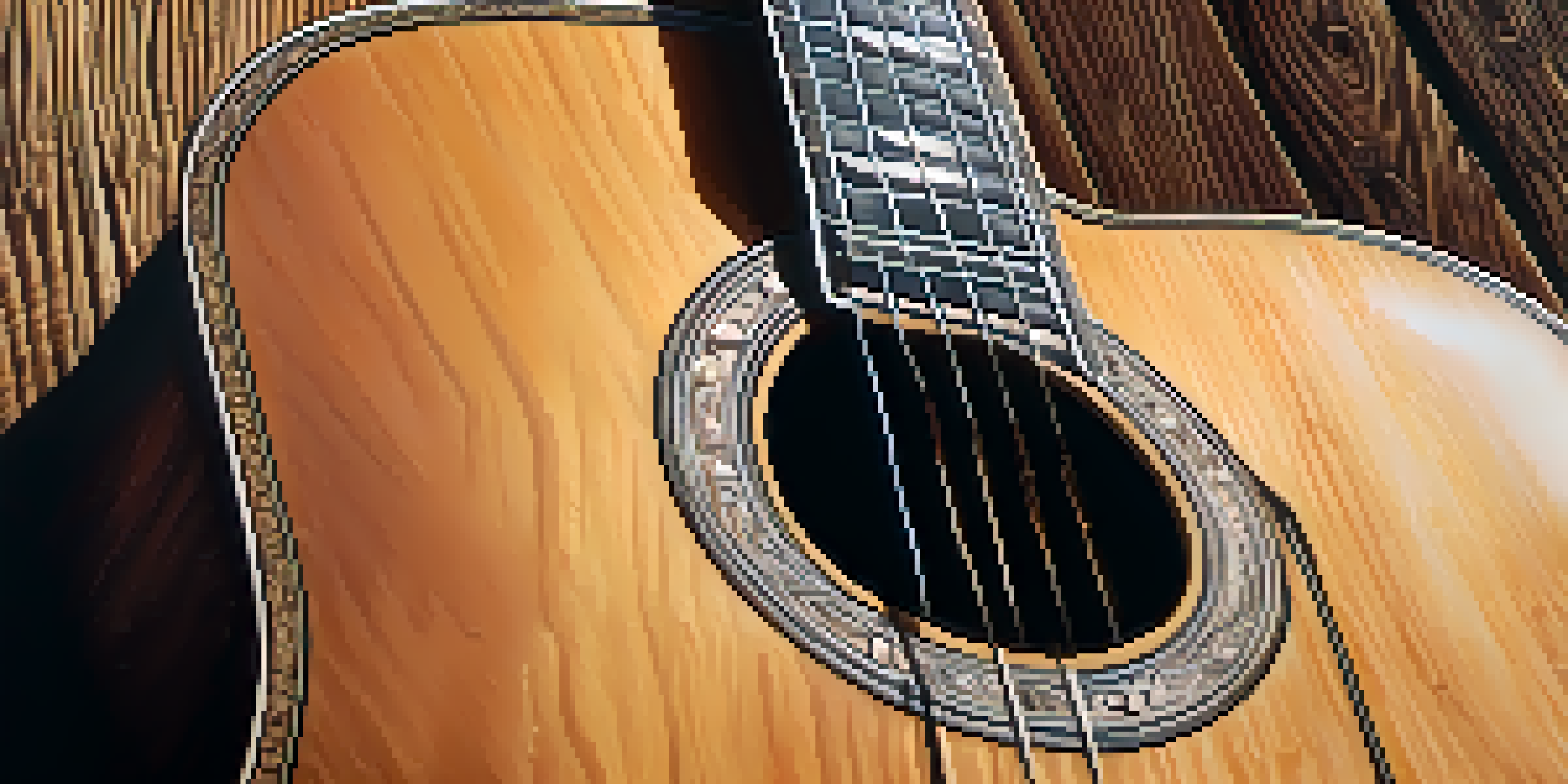Exploring Acoustic Guitar: The Heart of Folk and Beyond

The Acoustic Guitar: A Brief Historical Overview
The acoustic guitar has a rich history that dates back centuries, evolving from its early stringed ancestors. Its roots can be traced to various cultures, with different designs and materials influencing its sound and playability. By the 19th century, the guitar began to gain popularity in folk music, becoming a staple for storytelling and expression.
The guitar is a miniature orchestra in itself.
In the United States, the acoustic guitar found its home in folk traditions, blending seamlessly with various styles like blues and country. Artists like Woody Guthrie and Lead Belly showcased the guitar's versatility, using it to convey powerful messages through their songs. This period marked the guitar's rise as a symbol of cultural identity and social movements.
Today, the acoustic guitar continues to be a beloved instrument worldwide, bridging generations and genres. Its simple yet profound ability to create music has made it a favorite among both amateur and professional musicians. From coffee shops to concert halls, the acoustic guitar remains at the heart of musical expression.
The Anatomy of an Acoustic Guitar: What Makes It Unique
Understanding the acoustic guitar's anatomy helps us appreciate its sound and craftsmanship. Key components include the body, neck, and headstock, each playing a vital role in sound production. The wood type used in construction, such as spruce for the top and mahogany for the sides, greatly influences the guitar's tone.

The shape of the guitar also affects its acoustics; dreadnoughts, concert, and parlor guitars each deliver unique sound profiles. For example, dreadnoughts produce a powerful bass response, making them popular in bluegrass music. On the other hand, concert guitars tend to offer a brighter tone, ideal for fingerstyle playing.
Acoustic Guitar's Rich History
The acoustic guitar has evolved over centuries, becoming a vital instrument in folk music and cultural expression.
Moreover, the craftsmanship involved in creating an acoustic guitar can elevate its quality. Luthiers, or guitar makers, carefully shape and assemble each instrument, ensuring the right balance and resonance. This attention to detail contributes to the guitar's ability to convey emotion through music.
Acoustic Guitar Techniques: From Strumming to Fingerpicking
Playing the acoustic guitar opens up a world of techniques that musicians can explore, from strumming to fingerpicking. Strumming is often the first technique beginners learn, allowing for rhythmic accompaniment in songs. With practice, players can develop various strumming patterns to add depth to their music.
The beauty of the acoustic guitar is that it can express deep emotion with just a few chords.
Fingerpicking, on the other hand, offers a more intricate approach, enabling musicians to create melodic lines while maintaining harmony. This technique is particularly popular in folk and classical music, where the interplay between melody and accompaniment is crucial. Artists like Nick Drake and Joan Baez have showcased the beauty of fingerstyle guitar.
Additionally, advanced techniques such as hammer-ons, pull-offs, and slide guitar can enhance a player's expressiveness. These techniques allow musicians to add flair and emotion to their playing, making each performance unique. The versatility of the acoustic guitar ensures that there's always something new to learn.
The Acoustic Guitar in Folk Music: A Symbol of Storytelling
Folk music has long been intertwined with the acoustic guitar, serving as a vehicle for storytelling and cultural expression. The simplicity of the guitar allows for a focus on lyrics, making it an ideal companion for songwriters. Artists like Bob Dylan have used the guitar to communicate social issues and personal experiences, resonating with audiences worldwide.
The connection between the guitar and folk music is evident in its use at gatherings and protests, where it brings people together. Songs like 'This Land Is Your Land' became anthems of unity and resistance, showcasing the instrument's power to inspire change. The acoustic guitar remains a symbol of shared experiences and collective voices.
Techniques Enhance Musicality
From strumming to fingerpicking, various techniques allow musicians to explore and express their creativity on the acoustic guitar.
Moreover, the folk revival of the 1960s further solidified the acoustic guitar's place in popular culture. New generations of musicians embraced the instrument, blending traditional folk with contemporary sounds. Today, the acoustic guitar continues to play a vital role in folk music, evolving while staying true to its roots.
Influential Artists: Shaping the Acoustic Guitar Landscape
Throughout history, numerous artists have left an indelible mark on the acoustic guitar landscape. From legendary figures like Joni Mitchell to contemporary stars like Ed Sheeran, these musicians have pushed the boundaries of what the guitar can do. Each artist brings their unique style and voice, contributing to the instrument's rich tapestry.
Joni Mitchell, for instance, is known for her innovative tunings and fingerpicking style, creating unforgettable melodies that resonate with listeners. Her influence can be seen in countless artists who have followed in her footsteps, proving the guitar's versatility. Similarly, Ed Sheeran's use of loop pedals and percussive techniques showcases the acoustic guitar's adaptability in modern music.
Additionally, the rise of singer-songwriters has further popularized the acoustic guitar as a primary instrument for self-expression. Their intimate performances often highlight the emotional connection between the artist and their audience. This trend continues to inspire new musicians, ensuring the acoustic guitar remains a vital part of the music scene.
The Acoustic Guitar's Role in Modern Music Genres
While the acoustic guitar is often associated with folk music, its presence spans various modern genres. From pop to rock, and even hip-hop, the acoustic guitar has found a way to integrate itself into diverse musical landscapes. Its warm tones and organic sound provide a refreshing contrast to electronic elements, creating a unique listening experience.
In pop music, artists frequently incorporate acoustic guitars into their arrangements, adding an intimate touch to their songs. Hits by artists like Taylor Swift often feature acoustic guitar riffs, showcasing its versatility in mainstream music. This trend allows listeners to connect more deeply with the music, as the acoustic guitar evokes a sense of authenticity.
Care for Longevity of Your Guitar
Proper maintenance, such as regular cleaning and safe storage, is essential to keep your acoustic guitar in top condition for years of enjoyment.
Moreover, in genres like indie and alternative rock, the acoustic guitar serves as a foundation for creativity. Musicians experiment with different tunings and styles, often blending acoustic elements with electric sounds. This fusion enriches the music, appealing to a broad audience while maintaining the acoustic guitar's charm.
Caring for Your Acoustic Guitar: Tips for Longevity
To ensure your acoustic guitar remains in top condition, proper care and maintenance are essential. Regularly cleaning the strings and body can prevent buildup, enhancing sound quality. Additionally, using a humidifier can protect the wood from drying out or cracking, especially in fluctuating climates.
It's also crucial to store your guitar in a safe environment, away from extreme temperatures and humidity levels. A hard case or padded gig bag can provide protection during transport and storage. By being mindful of its surroundings, you can extend the life of your instrument significantly.

Lastly, regular professional setups can help maintain optimal playability. A skilled technician can adjust the action, intonation, and overall condition of your guitar, ensuring it plays beautifully for years to come. By investing time and care into your acoustic guitar, you'll enjoy making music for a lifetime.